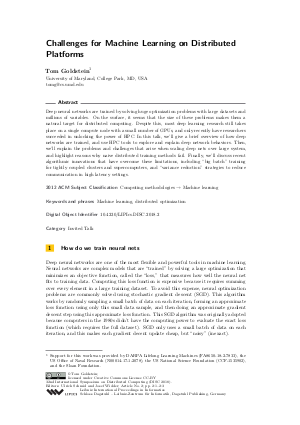Challenges for Machine Learning on Distributed Platforms (Invited Talk)
Author Tom Goldstein
-
Part of:
Volume:
32nd International Symposium on Distributed Computing (DISC 2018)
Part of: Series: Leibniz International Proceedings in Informatics (LIPIcs)
Part of: Conference: International Symposium on Distributed Computing (DISC) - License:
 Creative Commons Attribution 3.0 Unported license
Creative Commons Attribution 3.0 Unported license
- Publication Date: 2018-10-04
File

PDF
LIPIcs.DISC.2018.2.pdf
- Filesize: 279 kB
- 3 pages
Document Identifiers
Subject Classification
ACM Subject Classification
- Computing methodologies → Machine learning
Keywords
- Machine learning
- distributed optimization
Metrics
- Access Statistics
-
Total Accesses (updated on a weekly basis)
0Document
0Metadata
Abstract
Deep neural networks are trained by solving huge optimization problems with large datasets and millions of variables. On the surface, it seems that the size of these problems makes them a natural target for distributed computing. Despite this, most deep learning research still takes place on a single compute node with a small number of GPUs, and only recently have researchers succeeded in unlocking the power of HPC. In this talk, we'll give a brief overview of how deep networks are trained, and use HPC tools to explore and explain deep network behaviors. Then, we'll explain the problems and challenges that arise when scaling deep nets over large system, and highlight reasons why naive distributed training methods fail. Finally, we'll discuss recent algorithmic innovations that have overcome these limitations, including "big batch" training for tightly coupled clusters and supercomputers, and "variance reduction" strategies to reduce communication in high latency settings.
Cite As Get BibTex
Tom Goldstein. Challenges for Machine Learning on Distributed Platforms (Invited Talk). In 32nd International Symposium on Distributed Computing (DISC 2018). Leibniz International Proceedings in Informatics (LIPIcs), Volume 121, pp. 2:1-2:3, Schloss Dagstuhl – Leibniz-Zentrum für Informatik (2018)
https://doi.org/10.4230/LIPIcs.DISC.2018.2
BibTex
@InProceedings{goldstein:LIPIcs.DISC.2018.2,
author = {Goldstein, Tom},
title = {{Challenges for Machine Learning on Distributed Platforms}},
booktitle = {32nd International Symposium on Distributed Computing (DISC 2018)},
pages = {2:1--2:3},
series = {Leibniz International Proceedings in Informatics (LIPIcs)},
ISBN = {978-3-95977-092-7},
ISSN = {1868-8969},
year = {2018},
volume = {121},
editor = {Schmid, Ulrich and Widder, Josef},
publisher = {Schloss Dagstuhl -- Leibniz-Zentrum f{\"u}r Informatik},
address = {Dagstuhl, Germany},
URL = {https://drops.dagstuhl.de/entities/document/10.4230/LIPIcs.DISC.2018.2},
URN = {urn:nbn:de:0030-drops-97910},
doi = {10.4230/LIPIcs.DISC.2018.2},
annote = {Keywords: Machine learning, distributed optimization}
}
Author Details
Funding
- Goldstein, Tom: Support for this work was provided by DARPA Lifelong Learning Machines (FA8650-18-2-7833), the US Office of Naval Research (N00014-17-1-2078), the US National Science Foundation (CCF-1535902), and the Sloan Foundation.
References
- Soham De and Tom Goldstein. Efficient distributed SGD with variance reduction. In 2016 IEEE 16th International Conference on Data Mining (ICDM), pages 111-120. IEEE, 2016. URL: http://dx.doi.org/10.1109/ICDM.2016.0022.
- Soham De, Abhay Yadav, David Jacobs, and Tom Goldstein. Automated inference with adaptive batches. In Aarti Singh and Jerry Zhu, editors, Proceedings of the 20th International Conference on Artificial Intelligence and Statistics, volume 54 of Proceedings of Machine Learning Research, pages 1504-1513. PMLR, 2017. URL: http://proceedings.mlr.press/v54/de17a.html.
- Hao Li, Zheng Xu, Gavin Taylor, and Tom Goldstein. Visualizing the loss landscape of neural nets, 2017. URL: http://arxiv.org/abs/1712.09913v1.
